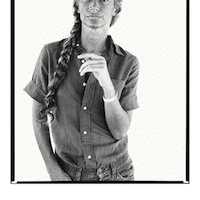If you’re one to frequent literary circles, you’ve probably heard Renata Adler’s name more than once over the past couple of years. When the New York Review of Books decided to exhume two of her novels, Pitch Dark and Speedboat, in 2013, they instigated an Adler revival, adding a new cohort of devotees to Adler’s already robust cult following. Now the NYRB is releasing a selection of her nonfiction— her reporting, film and book reviews, and commentaries on journalism—that will be a boon to fans of Adler’s fiction and to anyone interested in the state of contemporary journalism, particularly those who prefer a brand of reporting that elevates facts, the story, above the byline. Adler’s collection sets a rigorous standard for reporting that, in light of recent failures at major American magazines, is timely and refreshing.
After the Tall Timber covers a range of time and subjects, from Adler’s reporting on the civil rights march in Selma, Alabama, the wars in Biafra and Vietnam, and the Nixon scandal, to her essays on violence in film, Pauline Kael, and the Starr Report. It includes pieces from her collected reporting and criticism, Toward a Radical Middle (1970), her film reviews, A Year in the Dark (1969), and her essays on politics and media, Canaries in the Mineshaft (2001).
As a journalist, Adler is a proponent of facts first. Throughout these pieces, she lambasts the plague of celebrity that has afflicted the media, positioning herself as an enemy of the egocentric new journalist who “took up the personal and didn’t give a damn for the events… the facts dissolved. The writer was everything.” Instead, she reveres the humble reporter who eschews celebrity for the “reliability of pieces,” those “Times men in the South” who “were entirely free of self-importance or punditry, rather like good short-order cooks.”
In a poignant moment, she highlights the absurdity of a speech that New York Times executive editor Joseph Lelyveld gave to 80 newsroom editors in order to highlight the “malignancy of misspelled names.” Adler writers, “Every acknowledgement of an inconsequential error (and they are never identified as reporting errors, only errors of ‘editing,’ or ‘production,’ or ‘transmission,’ and so forth), in the absence of acknowledgement of any major error, creates at best a newspaper that is closed to genuine inquiry. It declines responsibility for real errors, and creates as well an affinity for all orthodoxies.”
Adler is authoritative and biting in her criticism, yet she is also utterly reasonable. In her introduction to A Year in the Dark, a collection of film reviews she wrote as the New York Times’ chief film critic from 1968-1969, she writes, “What I wanted to do with the job was to try, as a just-under-thirty person then, of fairly contemporary experience, to review films in earnest (or, in fun, depending on the film) with a bit more tension and energy than the traditional paper-way.”
And even when she is being deadly serious in her assessments, her acerbic essays and fact-intensive reporting have levity. Adler has a humorous eye, which she uses to hone in on the absurd. Her tone throughout the collection is reliably deadpan, as in describing the readership for her film reviews: “‘Our reader,’ particularly conceived by the culture editor, was a hypothetical, highly serious person, hanging from a subway strap, who had never read a book or seen a movie, used an obscenity, or slept with anyone, but who was desperately anxious that every character, however minor, involved in an way with the making of a film should be identified by some parenthetical reference to his prior work.” Adler can be just plain funny; her ability to flow between gravity and jocularity is impressive, a testament to her range as a writer. If she wanted to go the way of new journalists and let her personality resonate throughout her pieces, she would outshine most of them with her wit and intelligence. Her journalistic restraint, in light of such a personality, is admirable.
Ironically, Adler cannot hide completely behind her reporting. She is present in all of these pieces, a low-level vibration of critical genius.






One response
You got my vote . Like the interview, please come back. How do I stay in touch with you ?
Click here to subscribe today and leave your comment.